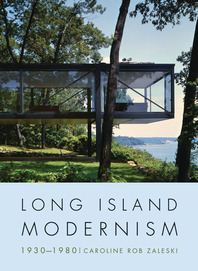
Long Island Modernism 1930–1980
12 October 2012
Description
Chronicles a rich and little-known array of architecture on the island, a hotbed of modernism from the thirties on.
Caroline Rob Zaleski’s research on the work of key figures in twentieth-century architecture; the relatively unknown aspects of their production; and their associations with clients, artists, and politicians is complemented by more than three hundred striking archival photographs, specially commissioned new photography, and plans. Zaleski documents the development of exurbia and the rise of visionary structures: residences for commuters and weekenders, public housing, houses of worship, universities, shopping centers, and office complexes. In this part architectural, part social history, she explains why modernism was embraced by Long Island’s civic, cultural, and business leaders—as well as by those who wanted to settle away from the city—during an epoch when open space was prime for development. An inventory of important architects, with their Long Island commissions by date and location, complements the main text.
Reviews
"[N]ot only highlights what the island offers in terms of modern architecture, it is an excellent primer on modernism itself." — Regional Planning Association
"[S]tunningly illustrates how modernism is alive and well on Long Island." — ON: A Global Lighting Publication
"Comprehensive, exhaustively researched, and carefully detailed . . . . [T]his is a book that enriches our understanding of an important component of twentieth-century culture and belongs in the library of anyone interested in the history of Modern architecture in America." — APT Bulletin: Journal of Preservation Technology
"With eye-opening photographs and surprising discoveries from a forgotten past, the new book Long Island Modernism: 1930-1980 surveys a wealth of pioneering architecture produced locally by famous builders from around the world." — The Wall Street Journal
"A sweeping and authoritative new book, Long Island Modernism 1930-1980, by Caroline Rob Zaleski thoughtfully covers the astonishing architectural and landscape architectural achievements in the area." — Huffington Post
"The book is more than a field study. Zaleski weaves extensive archival research, interviews and miles on the byways into a social and cultural history of Modernism on Long Island. . . . The book’s images surprise at every page turn and their large size pulls you into the design particulars. . . . When Zaleski writes that Rudolph’s houses have stood the test of time because they ‘never lost the sense of being from the future,’ she could be talking about much of Long Island’s Modern architecture. It’s there and this book will help you discover it." — DOCOMOMO
"The book is an erudite tour from Great Neck to Montauk through a vibrant half-century of architectural experiment. . . . Zaleski does an excellent job of explaining both the cultural and design background in detail." — Metropolis
"Zaleski rises to the occasion, as architectural writers so often don’t, when pressed into play to give social context to builders and their buildings. The book is a fascinating history as well as field study." — Architects Newspaper
"As one of the most representative regions of the great suburbanization of the American landscape in the twentieth century, Long Island was a veritable laboratory of modern architecture and town planning. Caroline Zaleski has not only discovered countless forgotten works of major importance by some of the leading practitioners of modernism—some even the émigrés who briefly thought to bring the Bauhaus to Huntington—but also traced whole new networks of influence. Extraordinary research and period images open up new paths of interpretation: on the impact of Marcel Breuer’s work on two generations up to the early work of Richard Meier, on the modernist initial idea of Levittown, on the role of landscape designers, on the experimental forms of postwar synagogues. A tour of Long Island is a tour of modernism with the right guide!" — Barry Bergdoll, Philip Johnson Chief Curator of Architecture and Design, Museum of Modern Art


